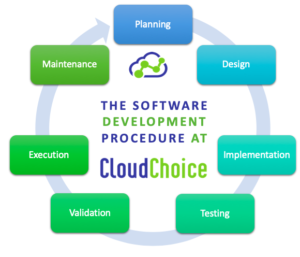Custom Development with Cloudchoice
With constantly rising need for updated technology and faster effective work, Custom software development has become an integral part of every business around the globe.
But, what exactly do we mean by Custom Software Development?
Custom Software development is a procedure involving several steps such as idea generation, planning, product design, implementation, testing, validation, execution, and maintenance.
Many times, businessmen fail to understand the language of coding. This acts as a barrier to accomplishing their organizational mission, goals, and objectives. Developers, on the other hand, find it difficult to communicate with prospective clients using the coding language. This is where CloudChoice Inc. comes to the rescue. CloudChoice Inc. helps clients solve their business problems through custom development of applications. It acts as a mediator between clients (seeking IT related solutions) and developers (seeking potential clients) in providing these solutions and helps bridge the gap.
In this article, we are going to quickly brush through the several steps involved custom development that we follow at CloudChoice Inc.

Custom Software Development
1. PLANNING:
Our clients approach us with their business problems and their own idea of how they intend to solve it. We understand their problems and turn them into technical tasks.
2. DESIGN:
We design our technical task into two categories viz. graphical and written. In the graphical category, we put up relevant pictures and images to reflect the visual representation of our solution. Meanwhile, in the written category, we write down the rules and instructions covering our client requirements. Once these two sub-tasks are taken care of, we send the documentation to our client for their approval.
3. IMPLEMENTATION:
Once we get an approval from our client, we send the design document to our respective development and testing teams to work on it. While the developers handle the coding, the testers write test cases/scenarios based on the approved design.
4. TESTING:
The testing team runs the relevant tests to ensure that our new application works according to our client requirements.
5. VALIDATION:
After successful testing, we provide a run-through to our client to ensure that the client is satisfied with the solution we have provided. On successful validation, we deliver our customized SaaS solution to our client.
6. MAINTENANCE:
Once the solution is delivered, we provide free support to our client for a few weeks during the solution rollout stage. Post that, clients have a choice to opt for a maintenance contract with us wherein any further concerns related to our solution is taken care of.
The waterfall model vs the agile methodology:
The traditional method or the waterfall model follows a very long procedure of moving one step at a time. Once a phase was accomplished in the cycle, the process would move ahead to the next phase. This is time-consuming and hence, no longer fits the ever-increasing demands of the customer.
Surpassing the negatives of the traditional method comes into picture the agile software methodology. As compared to the traditional way, agile methodology looks into client requirements and works on its solutions. This accelerates the delivery time, helps in managing the changing requirements of clients/customers and helps in better alignment of IT and business objectives. Emphasis is placed heavily on one-to-one customer feedback and communication which saves a lot of time.
Although it is a fairly new avenue for us, our clients love what we do for their businesses.
Got any suggestions or better ways to do this? Need custom software solutions to save time and increase efficiency?
Feel free to contact us.
Stay local. Think global!






